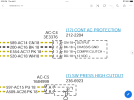The device you guys have been discussing is depicted as back to back zener, probably in a common package.
When the machines were upgraded to these it probably corrected more than the wiring issue Niege experienced.
When the current flow stops from the control device the magnetic field collapses across the winding in the clutch causing a back EMF in the order of 200V and several amps.
The problem using a convention diode across the coil to dissipate this current is that the magnetic field doesn't just collapse to zero.
It actually oscillates like AC with a sine wave shaped current many times on the way down to zero.
So a zener being bidirectional would suppress the reverse surge in both directions and have the effect much quicker suppression.
A conventional diode will probably be ok as a replacement but you may well hear a noise in your radio when the clutch disengages, and system will likely have a little more back EMF going back in the wiring.
If it is back to back zener it is testing faulty with your meter as should be high ohms in both directions.
When the machines were upgraded to these it probably corrected more than the wiring issue Niege experienced.
When the current flow stops from the control device the magnetic field collapses across the winding in the clutch causing a back EMF in the order of 200V and several amps.
The problem using a convention diode across the coil to dissipate this current is that the magnetic field doesn't just collapse to zero.
It actually oscillates like AC with a sine wave shaped current many times on the way down to zero.
So a zener being bidirectional would suppress the reverse surge in both directions and have the effect much quicker suppression.
A conventional diode will probably be ok as a replacement but you may well hear a noise in your radio when the clutch disengages, and system will likely have a little more back EMF going back in the wiring.
If it is back to back zener it is testing faulty with your meter as should be high ohms in both directions.
Last edited:


